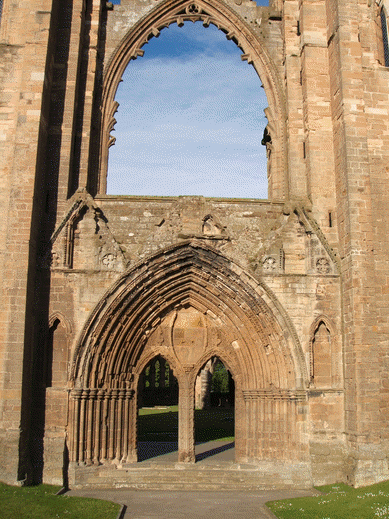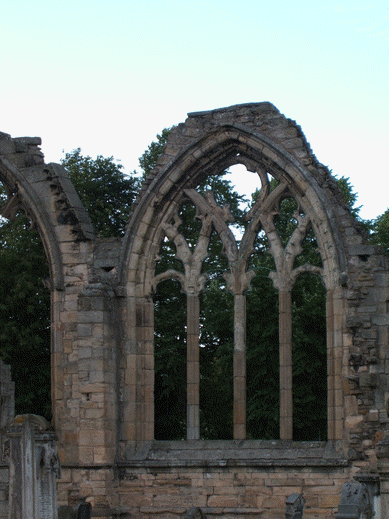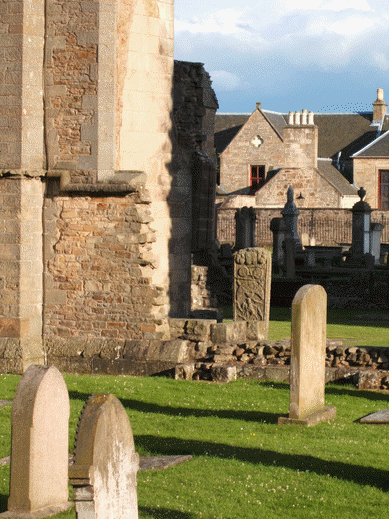(small).gif)
(small).gif) |
THE CATHEDRAL. |
There are other sites which deal in much more detail than these pages can afford with the actual building, long known as "The Lantern O' the North." However, I wish to add some less well-known information to the body of knowledge which is already available.
The cathedral church of the Holy Trinity was, without doubt, the finest building north of the Tweed, "noble and beautiful, the mirror of the land, and the fair glory of the realm". It was an earnest rival to many of the "great" medieval cathedrals of England and other parts of Europe.
It is principally late and transitional Early English in style. Cruciform in shape it was 282 ft long by 35 ft wide. It had, like Chichester, external chapels to the nave aisles, a small but ornate porch, and three magnificent towers. Only the bases of the west towers now remain the central one having fallen, much to the ruin of the other stonework. The remaining towers were originally topped by lead-sheathed wooden spires and, recently, the southern of the two west towers has been re-roofed but sadly, not with a spire!
A point which should be noted is that the nave was divided into five aisles by four rows of columns. This is an important point, as none of the other cathedrals in England or Scotland has five aisles. Elgin is the only example. It is usual, however, in France, and their presence in Elgin is a symptom of the intercourse and alliance between the two countries at the time. These double aisles were too wide to be roofed by the simple straight 'lean-to' roofs employed in all other cathedrals in Great Britain: and, if we pas through the south porch and look at the side walls, we see that the aisles had been roofed by a series of six gables, one at each bay. This is also peculiar to French cathedrals, and it is interesting to note that Elgin is the sole example of this method of roofing side aisles in Britain. A study of the bases of the pillars shows that these double aisles were added in the fifteenth century during restoration work after the fire of 1390. The absence of buttresses to the central part of the nave indicates that it was roofed in wood.
The great west doorway, superbly recessed c.1224-44, has, like Glasgow, a double portal. This doorway is amongst the finest examples in the whole of Britain. The window above is of later date every feature being of Decorated character. It is possible that this large window was inserted by Bishop Columba de Dunbar (1422-35), either because of damage to what had previously existed or merely to reflect the current vogue of the times.
 |
.gif) | |
| Great West Door today. | Great West Door (restored) |
The choir of four bays (c.1270-1390) was 86' 4" long and was probably arched with stone and not groined. The presbytery terminates in an aisleless Lady Chapel of two bays, 23 ft long, raised by two steps above the level of the other floors, and adorned with a very beautiful east window which is one of the most memorable features of the building. It is formed of two grant tiers, each of five tall lancets, filling up the whole extent of the wall, and separated by massive mullions like piers. Above the upper row is a great marigold window.
 |
.gif) |
 | ||
| Beautiful tracery in the south wall of the nave. | East End of the Cathedral (restored) | Pictish Symbol stone moved
from the churchyard of the old Parish Church into the nave of the Cathedral. |
On the north side, resembling to a degree the arrangement at Lichfield and York, a processional aisle leads to the Decorated chapter-house. This is now roofed again and the tracery of the windows has been restored and glazing fitted. Sadly, as yet, the glazing is very plain. This is the only example remaining in Scotland of a detached octagonal building with central pillar and vaulted roof. The central pillar retains a (unique in Scotland) stone reading desk.
|
|
|
The recently restored Chapter House |
The south wall of the south transept is especially interesting from its containing the oldest architecture of the Cathedral, and no doubt was really part of the original Church of the Holy Trinity. The various features all show that it belongs to the Transitional Period between the Norman and the First Pointed, which in Scotland occurred about the beginning of the thirteenth century.
Historic Scotland has invested tremendous resources towards the upkeep of the Cathedral's fabric and they are to be congratulated in this. They have even developed a stonemason's school beside the precincts. The Chapter House has been re-roofed and the windows replaced - sadly with what resembles "toilet glass" - but, perhaps when money allows, stained glass will be re-introduced. More recently, one of the west towers has received a well-concealed roof. Of course, The Dunbar Aisle to the south east still retains its original vaulted roof.
The Destruction - a story not for the faint of heart!
Of course, and unique in Scotland, the ancient Palace of Spynie, the magnificent fortified home of the bishops, can be visited about three miles to the north of Elgin on the main road to Lossiemouth.
|
|
| The Bishop's Palace at Spynie from Spynie Churchyard. |
e-mail: admin@cushnieent.force9.co.uk
© 2005 Cushnie Enterprises